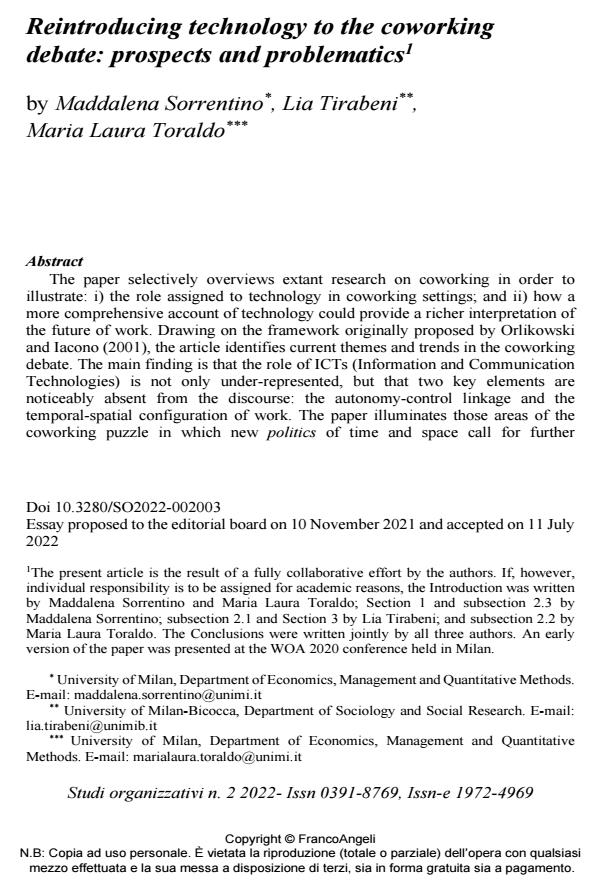Reintroducing technology to the coworking debate: prospects and problematics
Titolo Rivista STUDI ORGANIZZATIVI
Autori/Curatori Maddalena Sorrentino, Lia Tirabeni, Maria Laura Toraldo
Anno di pubblicazione 2023 Fascicolo 2022/2
Lingua Inglese Numero pagine 25 P. 70-94 Dimensione file 285 KB
DOI 10.3280/SO2022-002003
Il DOI è il codice a barre della proprietà intellettuale: per saperne di più
clicca qui
Qui sotto puoi vedere in anteprima la prima pagina di questo articolo.
Se questo articolo ti interessa, lo puoi acquistare (e scaricare in formato pdf) seguendo le facili indicazioni per acquistare il download credit. Acquista Download Credits per scaricare questo Articolo in formato PDF

FrancoAngeli è membro della Publishers International Linking Association, Inc (PILA)associazione indipendente e non profit per facilitare (attraverso i servizi tecnologici implementati da CrossRef.org) l’accesso degli studiosi ai contenuti digitali nelle pubblicazioni professionali e scientifiche
The paper selectively overviews extant research on coworking in order to illustrate: i) the role assigned to technology in coworking settings; and ii) how a more comprehensive account of technology could provide a richer interpretation of the future of work. Drawing on the framework originally proposed by Orlikowski and Iacono (2001), the article identifies current themes and trends in the coworking debate. The main finding is that the role of ICTs (Information and Communication Technologies) is not only under-represented, but that two key elements are noticeably absent from the discourse: the autonomy-control linkage and the temporal-spatial configuration of work. The paper illuminates those areas of the coworking puzzle in which new politics of time and space call for further investigation, positing that the scholarly spotlight needs to retrain on the role of technology.
L’articolo esamina selettivamente la ricerca sul coworking al fine di illustrare: i) il ruolo assegnato alla tecnologia nei contesti di coworking; e ii) come una diversa e più ampia concezione della tecnologia potrebbe fornire un'interpretazione più ricca del futuro del lavoro. Basandosi sul framework originariamente proposto da Orlikowski e Iacono (2001), l'articolo individua i principali temi e tendenze nel dibattito sul coworking. Il risultato principale è che il ruolo delle ICT (Tecnologie dell'Informazione e della Comunicazione) non è solo sottorappresentato, ma che due elementi chiave sono pressoché assenti dal discorso: il collegamento autonomia-controllo e la configurazione spazio-temporale del lavoro. L’articolo illumina le aree critiche che necessitano di essere approfondite, postulando che i riflettori della ricerca devono puntare decisamente sul ruolo della tecnologia.
Parole chiave:coworking, spazi di lavoro, tecnologia, pratiche organizzative
- Digital remote work and changes in managerial control Roberto Albano, Ylenia Curzi, in STUDI ORGANIZZATIVI 2/2025 pp.33
DOI: 10.3280/SO2025-002002 - Time-Space Patterns in Work and Organizing: Setting the Scene, Taking Stock and Moving Forward Sonia Bertolini, Anna Carreri, Dawn Lyon, Lia Tirabeni, in STUDI ORGANIZZATIVI 2/2025 pp.7
DOI: 10.3280/SO2025-002001 - Gli spazi collaborativi a supporto delle politiche place-based: pratiche organizzative e sfide nelle aree periferiche Stefano Rodighiero, Carlo Fusari, Fabrizio Montanari, Davide Sordi, in STUDI ORGANIZZATIVI 1/2025 pp.36
DOI: 10.3280/SO2025-001002
Maddalena Sorrentino, Lia Tirabeni, Maria Laura Toraldo, Reintroducing technology to the coworking debate: prospects and problematics in "STUDI ORGANIZZATIVI " 2/2022, pp 70-94, DOI: 10.3280/SO2022-002003